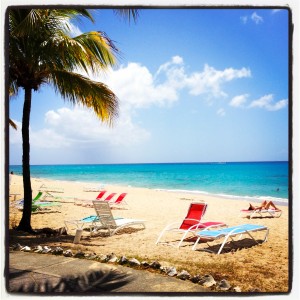This story begins at 12am, on the beach, under a sky full of stars in Sandy Point, St. Croix. We had begun patrolling at 8pm the previous day and had already seen one green turtle and one leatherback nesting. Around 1am, we were greeted by our second leatherback down the beach. Like the previous leatherback, we watched it crawl up the berm and beach, push the sand to form its body pit, dig its egg chamber, and lay its 80-100 eggs. However, with this particular leatherback, it had several injuries and chunks taken out of its back right flipper, creating some difficulty for it when digging its egg chamber. In order to give the turtle a little extra help, we allowed her to dig the chamber with her flippers and then we simultaneously scooped the sand she had removed. We decided to do this because she was unable to scoop and clear the sand out with her own right flipper. Therefore, we only helped her clear the sand she had already scraped off but did not interfere with the actual process of digging her specialized chamber and its internal integrity. After she laid her eggs, she proceeded to camouflage her nest with her front flippers. This specific nest didn’t require relocation, because she had crawled far enough up the beach to avoid placing her eggs in the erosion zone. However, about halfway through her camouflage process, another leatherback began to crawl up out of the water about 100 feet away, so our forces were divided between the two leatherbacks.
Several people stayed behind with the first leatherback in order to observe and record the time of her final crawl and re-entry into the ocean. The rest of us moved on to the next leatherback in order to begin data collection. We began with scanning for the internal Passive Integrated Transponder (PIT) tags and external visible flipper tags and then assessing whether she made if out of the erosion zone. These eggs were also not relocated because she crawled far enough up the beach that her eggs would not be threatened from seasonal sand erosion. Between 2am to 5am, we were lucky enough to see two more leatherbacks and observe the same process of nesting. Luckily, none of these clutches of eggs required relocation. Most of the turtles had scars on the carapace, chunks taken out of their rear flippers, and sometimes even an open wound, which unfortunately are fairly common with leatherbacks. These injuries are largely attributed to boat strikes, interactions with fishery equipment, and predator attacks. There have been different proposals on how to reduce fishery by-catch injuries, including illuminating the nets with lights that allow the turtles to see the net and avoid it, yet not reduce capture of the targeted fish. Research has also been done to find a smell or taste that the turtle don’t like but remains attractive to fish. To date, this has been less unsuccessful than the light method.
Overall, we had a successful night observing and helping with the leatherback nesting, and around 6am we were finally able to crawl into bed for a few hours of sleep. The rest of the day was spent recuperating on the beach and exploring the reef out front our cottages. Hopefully the next group tonight will be as successful with the number of leatherbacks that come up to nest!



